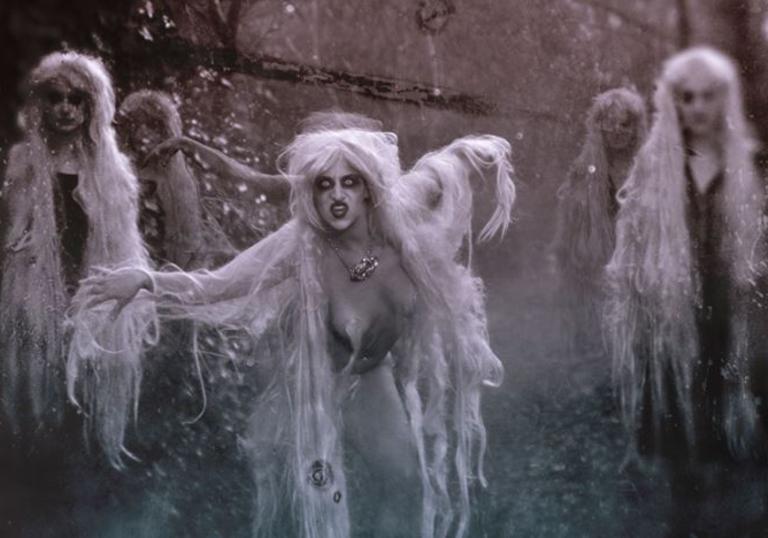This article contains strong language.
Which artists do you look to for inspiration and why?
Angela Carter (especially The Infernal Desire Machines of Dr. Hoffman, but also, everything she’s ever written) because she’s a fantastical, magical, feminist genius novelist. Her fiction teaches me about the nuance of feeling, the necessarily overlapping quality of being both an active and a passive subject, and how to create new worlds.
Ana Mendieta because the texture of her work is somehow both bold and restrained. Because her work on ghostliness and disappearance makes her own presence that much more tangible and political.
Alfred Bester (especially Golem 100) because his work is hilarious and smart, feminist, linguistical necromancy.
Andy Warhol because he played everybody.
Nicki Minaj because she is two different people, potentially on purpose – one that’s a black Barbie, and another that is pretending to be a black Barbie in order to sell records, but who is really a talented rapper. Whether we are meant to see both people in her, or their relationship, I’m not sure, but I’m intrigued.
Ryan Trecartin because he creates visually overloaded, overstimulating worlds of queerdom, that make use of/disrupt/enact the lexicon of pop phenomena and social mediation that so informs our contemporary visual culture.
You trained as a dancer, choreographer and completed a Master’s Degree at Laban. How did this training help inform your working practice?
I still see my work as choreographic. I trained my whole life as a dancer, as a teen with Alvin Ailey, then in university as a dance major at Northwestern, then at Laban. But for me, I kept coming across 2 obstacles with ‘dance’: 1) it became difficult to escape the marriage of ‘beauty’ and ‘women’s bodies’; and 2) I felt like dance, as a form, was somehow very descriptive, representational, expressive. I had to find my way through these obstacles. Obviously, many choreographers have pushed against these aspects in various ways throughout the history of dance and performance. The post-modern lineage from the 60s is an obvious example of this, which either rejected expression and representation, and/or rejected spectacle and the beauty we associate with virtuosity. But my way was through discovering the history and context of performance art, body art, and live art, in which, historically, there is an emphasis on action, on doing, rather than describing. My work now really plays on the borderlines of representation, making use of, or appropriating, these mechanisms of dance (expression, beauty, virtuosity), and repurposing them in order to critique, challenge or just call attention to, the ways we view the moving body on stage.
What does ‘feminism’ mean to you?
Here is one of many possible responses: ‘Feminism’ means to me constantly questioning, destroying, calling out, and disrupting the patriarchal norms that define the cultural society we inhabit. It is the act of creating problems – of problematizing the perpetuation of misogyny. This involves calling out misappropriations of feminism that do more harm than good. This appropriation happens dramatically in the spheres of commodity capitalism, popular culture, and mainstream media, in which ‘feminism’ is sold to consumers in such a way that actually undoes itself, and also encourages a white, privileged view of feminism. To me, ‘feminism’, means recognizing the systemic, institutionalized, internalized, physicalized, means of oppression that impact all women, or any woman. Most of these go unrecognized by most people on a daily basis.
‘Feminism’ means to me constantly questioning, destroying, calling out, and disrupting the patriarchal norms that define the cultural society we inhabit
What is a ‘witch-bitch ritual’?
A witch-bitch ritual is an act of pleasurable repulsion, of intentional delinquency, of unapologetically creating problems. It’s being the feminist killjoy in the room, unrepentantly.
It could be stripping down to nothing except a long grey wig and a pair of purple glitter sunglasses and floating in the ocean like a mermaid. It could be being the one at the pub telling your boyfriend’s friend to stop using the word ‘c*nt’ like a misogynist idiot. Or it could be dancing with your fellow witch-bitches in the woods around a fire wearing a necklace of decapitated penises. More often than not, it’s explaining to your grandmother over the dinner table why Cosmo isn’t the greatest place for feminist advice.
Where do you get your costume inspiration from? Where is your favourite place to shop for costumes?
The pound shop. Sex shops. McDonald’s. The everyday shopping-mall-goer is great inspiration. But this time David Curtis-Ring designed with me, so we’ve gone for the money option this time. The costumes for this show were inspired by Medusa, Mata Hari, Harajuku, Miley Cyrus, Katy Perry, and Victorian prostitutes and dancers.
There is a seriousness and a rigour behind my performance work
How is teaching different to performing?
The main difference between teaching and performing is that an audience receives The Famous and all her ambiguities, mess, loudness, etc., while my students receive Lauren, the academic (and everything that comes along with that version of myself). There is a seriousness and a rigour behind my performance work, which, of course, doesn’t emanate from The Famous in a readable way. In the classroom, however, that meticulousness is really communicated to the students through my teaching methods and my expectations of them as practitioners.

